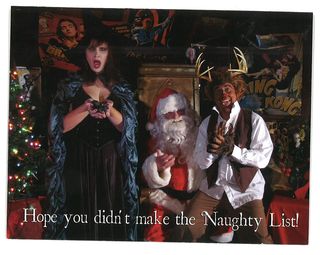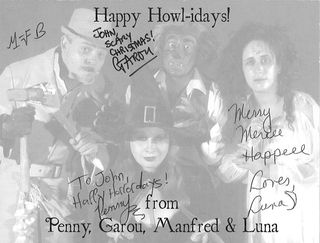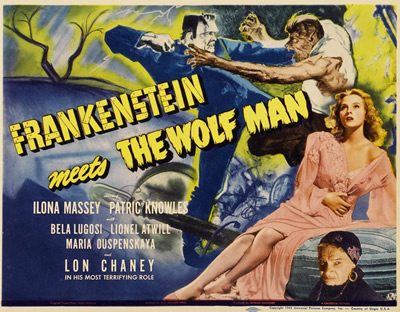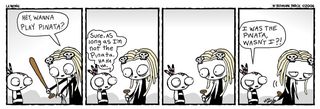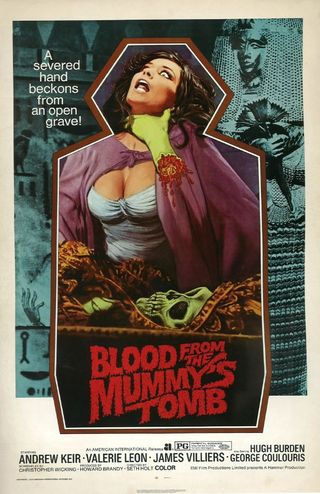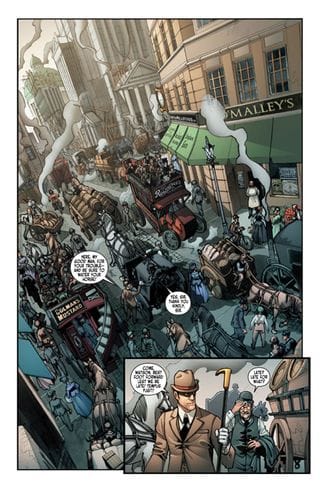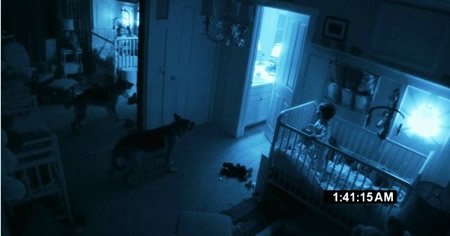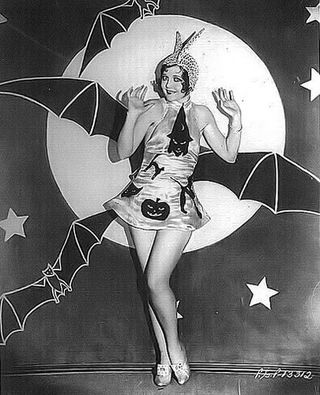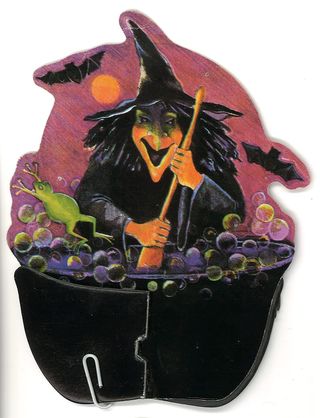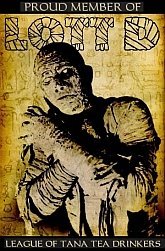From Zombos' Closet
From Zombos' Closet comes a classy and trashy collection of popular culture artifacts for those who love the terrors and treats found in movies, books, and Halloween.
December 17, 2010
December 15, 2010
Ghost In the House of Frankenstein Part 5
Frankenstein Meets the Wolf Man (1943)
Part 4: The Ghost of Frankenstein (1942)
Haven't we tried before to get rid of the Monster by force? We burned down the sanitarium and yet we didn't destroy Frankenstein's fiendish creation. We must be more clever this time. Let's use our brains for once. (Mayor of Vesaria in Frankenstein Meets the Wolf Man)
Frankenstein's creation has changed; both spiritually and physically, he behaves differently from when he first reaches upward toward the sunlight streaming in from the skylight his creator, Henry Frankenstein, briefly opens in Frankenstein. But was the Monster simply reacting to the light or reaching toward understanding it? And was Henry's abrupt closing of the skylight a sign of his reluctance to foster that understanding, to renege on his new role of being a parent?
These are questions no longer asked in The Ghost of Frankenstein, and they are expediently ignored in Frankenstein Meets the Wolf Man. By removing God and Henry's fatherly responsibilities from the equation summing Monster and soul, and by removing the mysterious cosmic spark of life present in the lightning, Universal's script writers could churn out simpler stories of mayhem, brain-swapping, and spook show dramatics unencumbered by philosophical and social musings. Like the Monster's soul, the spirit of the series had fled, to be replaced by rote movements deprived of deeper motivations, slickly paced on Universal's production treadmill so as not to even break a sweat.
But if you look closely at this treadmill you will see a glimmer of something new. Accidentally born out of necessity, perhaps, but still important to take note of. It's the beginning of what would become the essence of the 1950s sci-horror cycle, when science anomaly, outer space threat, and the well-intentioned but catastrophic effects of laboratory discoveries all move to the forefront of our fears, replacing the Gothic darkness and musty passageways of folklore. It is the cross of faith giving way to belief in the crucible of technology. Holy vestments previously used as defense against evil are replaced by the white lab coat and practical instruments used for experimentation, analysis, and resolution.
Vampirism?
It’s a malady of the bloodstream—science will cure it.
Frankenstein's creation?
It’s a botched surgical operation—proper medical procedure and simple electricity will correct it.
Lycanthropy?
It’s a mental disorder—a pressure on the brain that psychological intervention and medical skill will provide palliation for it.
Wielding this newfound confidence and superiority of scientific method over any natural or unnatural adversity is the self-assured scientist. He (and rarely, she) assumes the high status once held by the priest, to sermonize a new religion more palatable for the atomic age about to flourish; and more reassuring in the face of its abuse in an age of global conflict.
Blame it on a) the spiritual disenfranchisement brought on by the conflict of a second World War, or b) a society becoming more distrustful and less naive, or c) a loss of faith in God's handiwork because of both a and b.
Regardless of the reasons, the once frightening monsters of horror were becoming more understandable, more rational in cause and effect and, therefore, less threatening, rendering them weaker in their abilities to terrorize. To compensate for this power drain, Universal mustered the monster rally: if one monster isn't scary enough, two or more will do the trick!
Maybe.
In Frankenstein Meets the Wolf Man, the self-assured scientist's role is played by Dr. Frank Mannering (Patrick Knowles), and the precise point at which out with the old and in with the new takes place occurs when Larry Talbot (Lon Chaney Jr) wakes up in Queen's Hospital in Cardiff, after surgery to repair the head injury incurred from the bludgeoning his father, Sir John Talbot, delivered in The Wolf Man.
Before this, the rebirth of Larry Talbot's cursed existence in Llanwelly Cemetery, under a full moon, contradicts an older age of superstition, when the precious metal silver could end a werewolf curse with certainty, and bring peaceful death to its tormented victim. But not now and no longer, even here in this horror staple of windswept tombstones, moldy earth, and decaying corpses. The curse is not ended and Talbot is not killed by the pounding his feral noggin received with the silver-headed cane. To the dismay of the grave robbers who dared open his tomb, and the awakening Larry Talbot, the creeping moonlight revives the Wolf Man to hunt the streets and woodlands once again.
Come one and all and sing a song
Faro-la, faro-li!
For life is short, but death is long
Faro-la, faro-li!
There'll be no music in the tomb
So sing with joy and down with gloom
Tonight the new wine is in bloom
Faro-la, faro-li! (Song of the New Wine, sung by Adia Kuznetzoff, in Frankenstein Meets the Wolf man)
Once Roy William Neal (The Scarlet Claw) directs the moonlight to creep across the floor in Talbot's tomb and then again in his room in Queen's Hospital, Jack Pierce's man to wolf transformation begins. Talbot explains he's cursed, but the doctor believes him to be delusional. Biting through his straitjacket during a moonlit night, Talbot hoofs it to Maleva the old Gypsy woman for help. But Maleva (Maria Ouspenskaya) is of the old world and therefore powerless in this new age of medicine and science Talbot has awakened in. She tells him only Doctor Frankenstein may possess the knowledge to help and soon they are off to Vasaria to find the doctor.
What happened to the charm she gave him in The Wolf Man, to keep him from turning into a wolf? Why doesn’t she make another one?
Once again, Universal's timeless, placeless horror qualities—ones convenient for the scriptwriters, but hell on continuity—eschew motor vehicles for horse drawn wagons and muddle locations, again, for Frankenstein's laboratory.
Although Ludwig Frankenstein supplied the surgical skill in the previous Ghost of Frankenstein, his manor house and laboratory were destroyed by fire. The watchtower and laboratory shown here are similar to the ones Henry Frankenstein used in Frankenstein. Go figure. At least one quality, the ever ready torch-bearing mob (where DO they get those torches?), does change: the villagers carry lanterns instead. Not as exciting as burning clubs held aloft, but definitely more economical and manageable on set.
Another necessity has the Monster buried under or in something, waiting to be found and released in each movie. A rebirth, it seems, which occurs again and again: in Frankenstein, the cadaver for the Monster is unburied from a fresh grave; in Bride of Frankenstein, the Monster, buried beneath the burned-out windmill, is unwittingly freed; in Son of Frankenstein, after being buried in the rubble of the destroyed watchtower, the Monster is unearthed by Ygor; in Ghost of Frankenstein, Ygor digs out his only friend from the dried sulfur pit; in Frankenstein Meets the Wolf Man, Talbot stumbles onto the Monster, frozen in a block of ice, buried under the charred remains of Ludwig's manor house and sanitarium.
Or is it the watchtower?
Audiences didn't seem to care or notice how Frankenstein’s laboratory and monster-energizing equipment kept changing locale.
Talbot, who always manages to dress the part of the Wolf Man (same neat dark shirt, same neat dark (and pressed) slacks), after being chased into the ruins regains consciousness in his human form after falling into a catacomb filled with ice, frost, and burned timbers—a poetically eerie scene that exemplifies the Universal Horror mystique. He frees the Monster (Important! Don't forget Ygor's brain was transplanted into the Monster's cranium at the end of Ghost of Frankenstein), and the two of them chat up a storm over a brisk fire. Ygor, now in the Monster's body, tells Talbot about his tribulations in trying to reach his goal of ruling the world.
Wait. That’s wrong. That’s not what happened in the movie.
The Monster's lengthy speech, which explains the odd mannerism Lugosi had of holding his arms stiffly in front of him as he stumbles around because of near blindness due to blood type incompatibility (it happened at the end of The Ghost of Frankenstein), was cut.
In fact, all of Lugosi's speaking parts were cut. They were removed because preview audiences giggled at the Monster speaking in Lugosi's heavily-accented voice. At least this is the reason often cited by movie historians, repeating the explanation given by Frankenstein Meets the Wolf Man's scriptwriter Curt Siodmak.
But is it entirely true?
The important continuity support needed to make sure the audience remembered the Monster was now Ygor, whose brain was plopped into the Monster’s cranium in Ghost of Frankenstein, no longer existed. There was no chance Lugosi would give a convincing performance because Siodmak's dialog, and Neal's efficient but standard direction of the Monster's talking scenes, highlights the Monster speaking, not Ygor as the Monster speaking. Without this understanding, Ygor’s voice, spoken by the Monster, appears incongruous.
One effective continuity builder Siodmak and Neal could have used would have been a flashback showing Ghost of Frankenstein's climax to reestablish Ygor's presence in the Monster's body. Dialog exchanges between Talbot and the Monster could also have been written with more regard for Lugosi's unique speech patterns (less dialog for him), and more carefully chosen words when he did speak. Talbot also shouldn't be calling the Monster “dumb” as he does in the original script, and the Monster begging for help is out of character even for Ygor.
“Don’t leave me–don’t go! I’m weak…They’ll catch me and bury me alive!” (Frankenstein Meets the Wolf Man, Universal Moviescript Series, Classic Horror Movies, Volume 5)
While it’s easy to assay Lugosi's role as inadequate, he received little help from the script and the subsequent revisions to the movie to be successful.
After the Journal of Life and Death (or How I Did It if you're a Young Frankenstein fan) is found with Baroness Frankenstein's (Ilona Massey) help, Dr. Mannering, who's been tracking Talbot all over Europe, discovers that changing the plus and minus poles on Frankenstein's equipment can either strengthen or deplete electrical energy. Mannering, falling under the Frankenstein curse of hubris (or perhaps simple curiosity), decides to power up the Monster while draining the life out of Talbot to end his werewolf curse.
Oddly, Mannering decides to do this during a full moon.
Cue the slugfest between a rejuvenated Monster/Ygor and the Wolf Man and the destruction—again—of the laboratory. No mention is made of Maleva’s whereabouts after everything blows up, but being Old World anyway, she’s no longer needed to prop up the supernatural aspects of the franchise since they were no longer needed. (Her unexplained absence later in the film was due to an on set injury. I guess they thought no one would notice.)
, Frankenstein Meets the Wolf Man remains an energetic and enjoyable excursion to Universal's quintessentially obscure world of mad science and monsters. And we even get to see Dwight Frye one last time.
Both the Wolf Man and the Monster wind up frozen in ice under the flooded ruins of Castle Frankenstein, waiting to be freed in House of Frankenstein. Like the Monster, the ubiquitous laboratory equipment is just as immortal, and those neck bolts beckon for yet another round of mad science.
Time for the mad scientist to make a house call.
Posted at 03:31 PM in Universal Monsters | Permalink | Comments (0)
Tags: bela lugosi, frankenstein meets the wolf man, horror movie review, lon chaney, universal studios horror
December 09, 2010
Graphic Book Review: Lenore, Cooties
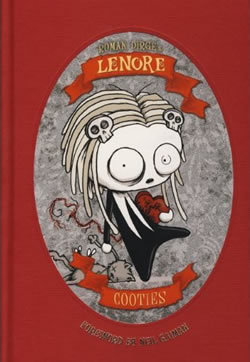 . ZC Rating: 5 of 7 (Excellent)
. ZC Rating: 5 of 7 (Excellent)
Lenore, the cute little dead girl, springs to vivid life, in full color, in Cooties. This Titan Books hardcovered, colorized edition of Roman Dirge's comic book series collects issues 9 through 12. Here's how I can best describe Dirge's misadventures for his adorable, rotten-stuffin', googly-eyed waif.
What if Dennis the Menace were a girl living next door to the Addams Family? He'd be, she'd be Lenore.
What if Eddie Munster had an incredible two-headed transplant with Dennis the Menace and dressed like Wednesday from the Addams Family? He'd, they'd be Lenore.
What if the Brady Bunch and the Beeve--after spending summer vacation at 1313 Mockingbird Lane-- went through an ion storm filled with screwed up cosmic rays, while locked in the trunk of the Jupiter 2, that was being towed at sub-warp speed by the U.S.S Enterprise NCC-1701, which was being trapped by a Tholian Web? They'd be Lenore's friends.
What if you read this book and didn't find it funny as hell in that morbid, cockamamie sick sense of humor way horror fans tend to exhibit? Impossible.
Lenore's endearing charm, even if worms are boring through her cranium now and then, and she surrounds herself with festering friends, comes from her irresistible, child-like sense of what's most important: like leaving the afterlife because it's itchy and smells a lot like Fritos and making a death mask for fun.
In Cooties, her friends, who (gramma' nazis, feel free to insert whom here) wear more than clothes, dig her up, which leads to Pooty the bounty hunter--aside from being little, I can't make heads or tails what he is--being sent to bring her back to the afterlife. Much mayhem ensues as he fails in his mission, causing a slubby netherworld army to be sent instead. Of course, with Lenore, much mayhem ensues daily anyway.
In-between this continuing turmoil, Dirge tosses in a few heaping helpings of grue like Pop Goes the Weasel (the weasel does, really), and his own strange encounter with a talking urinal in Japan (believe me, I know, I've been there). Copious pin-ups, issue covers, and I-can't-believe-he-actually-did-that moments stretch the boundaries of good taste and decorum. Dirge will spare no cliche, no oft-turned phrase, no sordid joke or crass visceral visual to make Lenore as banana ripe and cheeky as the day before she died.
Neil Gaiman supplies the foreword. He's strange, too.
Titan Books supplied a courtesy copy for this review. I already have the black and white comic book issues, though, so this is icing on the cake, for sure.
Posted at 02:52 PM in Books (Graphic) | Permalink | Comments (0)
December 02, 2010
Sticky Blinking Eyeballs:
The Perfect Holiday Gift?
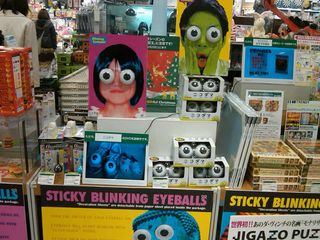 While in Japan's Tokyu Hands department store in Kashiwa, my eye was caught by these techno-monster, blinking ones. Don't know for sure, but this may be the best holiday gift this year.
While in Japan's Tokyu Hands department store in Kashiwa, my eye was caught by these techno-monster, blinking ones. Don't know for sure, but this may be the best holiday gift this year.
Or maybe not. I'll leave it up to you.
It does bring the saying "jeepers creepers, where'd you get those peepers?" to vivid life, though, and you can actually tell people where you got them.
Posted at 06:28 AM in Reflections | Permalink | Comments (0)
November 19, 2010
Book Review: The Art of Hammer
Zombos Says: Very Good
Carreras was a charismatic salesman, and the only British producer to strike distribution deals with every major American studio. He was often able to do this without a script or the promise of major stars, but he rarely went into negotiations without provisional poster artwork and a title. (from the Introduction, The Art of Hammer)
Let's be clear: the art in Hammer Studios' movie posters is promulgated on crass commercialism and designed toward a preponderance of lurid, gamy imagery, and deplorable subject matter. Thank the lord all of this sordidness is captured in Titan Books The Art of Hammer, a necessary reference for that studio's movie poster art, which was created when posters really mattered for whetting the appetites of production backers and selling theater seats.
With no Internet viral campaigns, no chit-chatty forum quorums, no message board hype, and certainly no social networking picky-pecking, blurby-wordies to sell a movie, Hammer's artists combined bold imagery, screeching colors, and pow-zam-boom verbiage to titillate the vulgar interests of movie goers, stimulate the monetary interests of distributors, and annoy everyone else enough so they took offense and complained, providing even more word of mouth promotion.
Movie poster art became a passion of mine starting around 1968, when, in a small Hawaiian theater showing The Love Bug I saw a hand-painted poster for the movie in the lobby. Now, before you wonder why anyone would do a hand-painted poster for thatmovie (or whyI would go and see it), I'll cut you short and tell you to focus instead on the word hand-painted. Maybe they didn't have enough printed posters to go round, or maybe they couldn't afford more than a few, but whoever did the painting knew exactly what a movie poster needs to do. That person copied the print poster but made it more fun, more vibrant, so Herbie jumped out at you as you walked past, exclaiming "you must see me in this movie!" That's when I realized how important movie poster art really was, and still can be, once you look past the lenticular novelties and static photographic ensembles posturing for your attention in the theater lobby today.
Marcus Hearn (Hammer Glamour) returns to annotate an array of horror, comedy, potboiler, and exploitation posters that scream "you must see this Hammer movie!" beginning with 1950's screen-printed The Dark Light, and continuing up to 1979's The Lady Vanishes. Not all of Hammer's movies are represented due to lost artwork, but what's here is a grand sampling of styles and artifice. Hearn points out the prevalence of victimized and terrified women in posters that began in earnest with the Gothic Horror offerings. Up until then, men and women are shown together (usually embracing), or a dramatic depiction of action from the movie comprised the composition; afterward, it's mostly women and monsters in various postures of terrified and terrorizing hawking the movie, with American poster versions usually rendered more sensationally. Indeed, much of the fun in viewing these posters comes from comparing the British, American, Spanish, German, and Belgian versions for the same movie, each doctored to the acceptable (or barely tolerable) limits allowed by that country's standards.
Movie posters are arranged by decade and Hearn adds brief comments here and there explaining important changes in style and provides notes on the artist or artwork involved. My favorites are, of course, the mix of horror's vampires, mummies, and Frankenstein Monsters. They fostered an artistic expression leading to interesting interpretations, such as The Mummy's title monster having a gaping hole in its chest through which a pursuing bobby's flashlight shone through:
"The Mummy was still in production when Peter Cushing first saw Bill Wiggins' painting. Concerned that it misrepresented the film, Cushing asked director Terence Fisher if he could add a scene where his character drove a harpoon through the mummy's body."
The influence of pop art can be seen in the 1970s as more psychedelic colors and groovier layouts kick in, eventually followed by more photographically oriented compositions to trim the budget. Surprisingly, I never noticed the phallic inferences Vic Fair drew into the British Vampire Circus poster until Hearn pointed them out. How that got passed through the stringent British Board of Film Classification is a wonder.
If I were pressed to find one fault in The Art of Hammer, it would lean toward a preference I have. All posters are oriented in portrait, which does make the book easier to browse through. Given its coffee table size I agree it would be a bit of a bother to swing the book from portrait to landscape orientation to view posters, but some posters that would easily fill a full page in landscape view are short-changed by presenting them in the smaller, portrait view. Nonetheless, I recommend this as a superb horror fan gift to give or to get. It's naughty and nice and filled with spice.
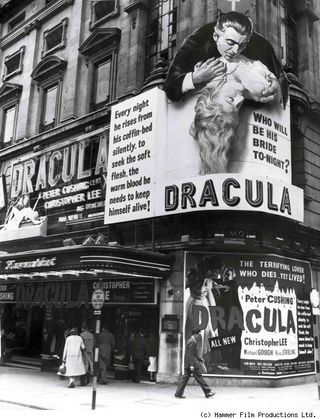
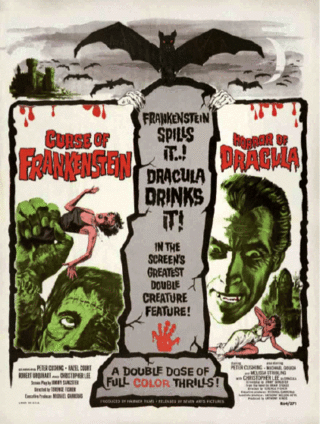 A courtesy copy of The Art of Hammer was provided by Titan Books for this review.
A courtesy copy of The Art of Hammer was provided by Titan Books for this review.
Posted at 04:16 PM in Art/Animation, Books (Non-fiction) | Permalink | Comments (4)
November 17, 2010
Comic Book Review: Victorian Undead
Sherlock Holmes vs. Dracula 1
After defeating Professor Moriarty's army of zombies in Victorian Undead, Holmes and Watson are confronted with the puzzle of what happened to the Demeter's ill-fated crew. Called on by Lloyd's of London to investigate, the world's first consulting detective and his faithful Boswell will soon learn there are far worse things awaiting them than zombies.
Or will they?
While the story is crisply paced, with Ian Edginton carefully dropping period elements (like references to the Lutine Bell and Shank's pony) into his pages, his Holmes and Watson seem to be falling into a Basil Rathbone and Nigel Bruce relationship. I do love them in the Universal Studios' movie series (especially the cleverly updated ones), but it doesn't match the tone of what Sir Arthur Conan Doyle wrote and tends to undermine the strengths of both characters in this graphic novel format.
Tom Mandrake's single page depicting Dracula aboard ship stands out dramatically from Fabbri's smooth, tidy lines for London and therein lies another departure from the quintessential element of the Holmes' Canon: Victorian London's shadowy byways, cramped quarters, foggy and sooty streets, and colorful denizens. Fabbri puts everything through the dry cleaners instead, including Holmes.
Look at the splash page (click to enlarge) and you'll see a surprisingly neat and orderly crowd in the hustle and bustle. Doyle once remarked that London was "the great cesspool into which the loungers and the idlers are irresistibly drained." Granted much of that cesspool was raised by fire in the first volume of Victorian Undead, in an effort to stop the zombies, but Fabbri's penchant for commercial cleanliness throughout his panels spills over onto Holmes, whose "bohemian" habits and lifestyle, as Watson wrote, are nowhere to be seen.
Perhaps I'm overly spoiled by watching the Granada television series and Jeremy Brett's virtuoso eccentricities. Looking at Fabbri's opening splash page , I know he can muster more of that atmoshpheric energy across the next four issues.
Come on Fabbri, give us some foggy streets at least.
Posted at 09:40 PM in Comics/Manga | Permalink | Comments (2)
November 15, 2010
Movie Review: Skyline (2010)
Not Much to See
Zombos Says: Fair
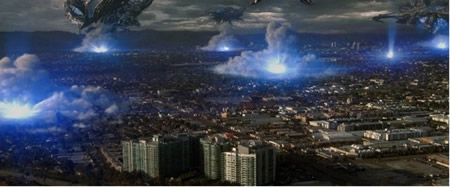
Here it is in a film cannister: if you've seen the trailer for Skyline, you've seen the most exciting part of this slimy-aliens-from-space pulp drama of Borg-like ( part machine, part organic, all regenerating), Matrixy-looking, multi-tentacled creatures vacuuming up humanity through a sparkly blue light as easily as dust mites are sucked up an Oreck.
In this war of the worlds special effects opus of us losing against them big time, the kicker here is they want our brains, which they use like Energiser batteries to power either themselves or their machinery, or maybe it's both. I will, with difficulty, refrain from making any dead battery jokes just because they're attacking Los Angeles, but feel free to infer whatever you like, or even change the locale to suit your preference.
It looks like Independence Day, but it doesn't have that movie's patriotic enthusiasm or energetic characters; it looks like War of the Worlds (old and new versions), but it doesn't have either of those movies' overwhelming sense of decimation, growing futility, or soul-numbing despair; it even looks like 1954's Target Earth, whose hunting mechanoids scour the city's streets for survivors in hiding. With Skyline mashing dramatic ingredients from many science fiction movies, the Brothers Strause fail to add any of their own sugar and spice to the familiar effects to make this more satisfying than the Coke and Reese's Pieces I had while watching it.
I will pin much of the blame on the dialog: it's stultifying. None of the pretty people trapped in Terry's (Donald Faison) penthouse speak in their own words. They bicker, they yell, but in stock, one-line sentences. Pick any two people and switch the dialog around; there would be no difference. The ugly aliens have more personality and they don't talk.
As Los Angeles is vacuumed clean of residents, Terry's house guests hide from the invaders with the blinds drawn. His automatic window blinds reminded me of the house shields in Forbidden Planet. They weren't very effective either. There's Jarrod (Eric Balfour), his girlfriend Elaine (Scottie Thompson), Terry's girlfriend Candice (Brittany Daniel), and Terry's personal assistant (emphasis on personal) Denise (Crystal Reed).
They disagree on whether to stay or make a run for it. Eventually they reluctantly run, but a giant alien stomps on their escape. Oliver (David Zayas), the concierge, comes to their rescue. He and Jarrod disagree on whether to stay or make a run for it. Much of the movie seems to be spent on everyone disagreeing on what to do next. A possible tension-mounting relationship between Candice, Denise, and cheating Terry is quickly stomped on, too.
They watch as the military shoots nukes at the motherships--over Los Angeles--but the blown apart ships regenerate. A few soldiers are dropped by helicopter to fight the maruading aliens, but they lose. Jarrod takes Elaine up to the roof, hoping they can escape by helicopter. The aliens intervene and they are captured. We get to see inside the mothership, how nasty the aliens are, and the groan-inducing potential for a sequel. However, I'll admit I do like the ending: it's hokey but pure pulp science fiction in tone.
Skyline is a straight to DVD movie that somehow got a lot more money to add a lot more fiery special effects. Now that's science fiction.
Posted at 01:24 PM in Movies (Bad) | Permalink | Comments (2)
November 09, 2010
Professor Kimena's Monster Kid Reflections
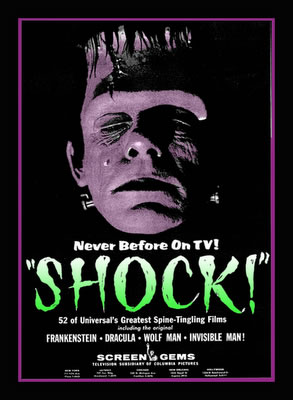 Professor Kinema (Jim Knusch) shares his ghoul-times growing up as a Dr. Denton's attired Monsterkid, his discovery of Shock Theater, and his ongoing passion for fantastic cinema, horror hosts, and monster magazines. Along the way, he picks some bones to rattle in the closet, contributes to the first Horror-Thon in New Jersey, and talks about the Zacherley fan clubs. (Those rattling noises you hear may sound familiar.)
Professor Kinema (Jim Knusch) shares his ghoul-times growing up as a Dr. Denton's attired Monsterkid, his discovery of Shock Theater, and his ongoing passion for fantastic cinema, horror hosts, and monster magazines. Along the way, he picks some bones to rattle in the closet, contributes to the first Horror-Thon in New Jersey, and talks about the Zacherley fan clubs. (Those rattling noises you hear may sound familiar.)
Copies of what’s housed in Professor Kinema's Archives, whether they be DVDs of video material, CDs of audio material, or reproductions of any and all printed material (stored on discs, flash drives or hard copy printouts) can be made available to the serious researcher. Specific listings can be provided along with proper arrangements.
A strong early childhood memory of mine is lying in bed, wide awake, listening to the muted sounds of the TV set in the living room. Dim light patterns were visible on the hallway wall just outside of my bedroom door, changing with the muted sounds. Naturally I wondered what these sounds and shadow plays looked like after my bed time.
Earlier in the day, up until bed time, I was allowed to view what one of my teachers referred to as ‘the one-eyed monster.’ This consisted of kid’s and family programming I could identify with. What was being broadcast after I was sent to bed became very mysterious. I posited that one of the acquired privileges of being a ‘grown-up’ meant that one could stay up as late as they wanted and watch TV.
Eventually, on Friday and Saturday nights, I was allowed to stay up late and see what the tube had to offer. Sitting there in my Dr. Denton's (yes, one button was always undone) I discovered that what I was imagining to come over the TV airwaves was a bit different from what I was viewing. It was ‘grown-up stuff’ that I found I didn’t really understand and wasn’t interested in. But wait! Later at night, after the news and weather, came something unique…vintage monster movies. My two younger brothers usually bailed out by this time and went to bed. The only light in the living room came from the TV. Now the shadows were happening all around me. The sounds were low, but sharper. No one else in the household found such fare interesting so my next strong childhood memories consist of sitting by myself, enjoying the exploits of all sorts of grotesqueries that included Frankenstein, Dracula, the Wolf Man and the Mummy. Here in the late 1950s a Monsterkid was born.
This Monsterkid still sits up late at night, alone, watching vintage monster movies.
In the household, I was the one, albeit self-appointed, who was mainly responsible for getting the best signal on the TV. Cable, or ‘pay TV,’ was an entity not even heard of at this time. The roof antenna was of a bargain basement variety type, made of cheesy, easily breakable aluminum. Pointed in one direction, the airwaves from the west, from New York City, came in the strongest. Pointed more toward the North, the few stations from the nether regions of Connecticut, ‘across the pond (the Long Island Sound)’ from our residence on Long Island, came in stronger. Late Friday and Saturday nights, the horror films permeated the airwaves, beaming in from Connecticut.
Naturally, I was the only one willing to climb up on the roof to position the antenna. My kid brother, by no real fault of his own, was very little help in determining what the best signal was. He would yell back to me, “Yea, that’s the best picture!” But when I climbed back down he would announce, “It was really better before,’ and so on…ad nauseum. To be able to settle in and enjoy a late night’s fare of grainy B&W, flickering iconoscopic fantasma, and be an accomplished Monsterkid, I had to shift for myself.
By the 5th grade it was ‘cool’ to discuss what we were watching on TV, as well as what we went to see in the movies. Monster movies usually dominated the conversation. The exploits of the current monster movies (the ones that parents let their kids see, or simply didn‘t care) were usually culled from Saturday afternoon ‘kiddie matinees.’ The topics of the more vintage ones was from the fare I discovered late on Saturday and (sometimes) Friday nights.
One day a classmate said to me, “You ought to check out this man who just started on TV on Saturday night. He looks like a monster, but he’s funny.” This piqued my interest. That next Saturday night I tuned in and discovered Shock Theater (marketed as Shock!) and it’s bizarre host…Zacherley. Yes, he definitely looked like a monster, but he was most assuredly funny. For the remainder of 5th grade, talk always included the most recent TV escapades of Zacherley.
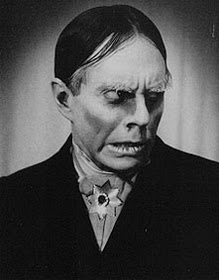 Shock! had existed in the New York area in the 1957-58 season, but sans host. By the beginning of the 1958-59 season (Son of Shock!) , scores of horror host fan clubs had materialized around the country. Zacherley, who had been hosting Shock! on WCAU in Philadelphia as ‘Roland’ (accent on the second syllable), had the most fan clubs of all the Horror Hosts who were haunting the airwaves. Because of this popularity he was invited, with an increase in salary, to haunt the airwaves of New York City (on WABC).
Shock! had existed in the New York area in the 1957-58 season, but sans host. By the beginning of the 1958-59 season (Son of Shock!) , scores of horror host fan clubs had materialized around the country. Zacherley, who had been hosting Shock! on WCAU in Philadelphia as ‘Roland’ (accent on the second syllable), had the most fan clubs of all the Horror Hosts who were haunting the airwaves. Because of this popularity he was invited, with an increase in salary, to haunt the airwaves of New York City (on WABC).
Fading in with an accompanying wolf howl, the show would begin, framed on some close-up section of the set. This was often a flickering candle, hypodermic needle, or skull--usually covered with cobwebs. To our sensibilities this was the ‘house of Zacherley.’ Strange things were hanging on the walls and occasional strange sounds were coming from somewhere off screen.
The camera would pan either right or left to frame Zacherley actively involved in some sort of bizarre activity. At this time he would then notice the viewer and speak directly to the camera with a cheery, “Hello! Zacherley here!” and give some sort of explanation as to what he was up to. One got the impression that he lived in these surroundings with cameras all around, poised and ready to go 24/7. At this particular time of the week these cameras would suddenly turn on to catch whatever he was doing at that time. Accordingly, when the show ended, he would continue with his bizarre activities until next week, when the cameras would reactivate and we, the viewers, would again visit via the magical realm of TV.
When the week’s movie began, the anticipation became high: when was he going to be briefly seen during the movie’s run? Eyes were glued to the screen, eagerly awaiting that moment. He didn’t disappoint. After the commercial break he was back in his usual surroundings, making a few off-the-cuff comments about the movie and continuing with the bizarre activity. His standard closing at the end of every show was the memorable, “Goodnight, whatever you are!” I, as well as tens of thousands of other viewers, had never seen anything like him. He was unique, he was bizarre, he was funny, he was entertaining. Therein is the essence of his cult status.
Continue reading "Professor Kimena's Monster Kid Reflections" »
Posted at 03:38 PM in Kinema Archives | Permalink | Comments (0)
November 05, 2010
Movie Review: Paranormal Activity 2 (2010)
Pavlovian Horror Redux
Zombos Says: Good (but stretches camera POV thin)
Watching Paranormal Activity 2 I felt like one of Ivan Pavlov's dogs, but instead of salivating at the sound of a bell, I would watch the screen more intently each time a low rumbling noise alerted me to the onset of a supernatural event. I can't readily recall any other horror movie franchise that purposefully conditions you to wait for something to happen by making you watch near endless home video recordings of the same scenes, again and again, in anticipation of something happening. Either this is an ingenious use of minimalist cinema verite and camera POV, or we're being suckered big time. Maybe it's a little of both.
A prequel and sequel rolled into one, the reason for the haunting is also hinted at, removing the unsettling feeling of this-could-happen-to-anyone you get in Paranormal Activity, but leaving room for another franchise entrant. Since the explanation involves family members back in the 1920s, you'd have to show it through box camera and scrapbook photographs, and hand-cranked newsreel footage instead of modern handycams and convenient home security cameras, like the ones watching Hunter's bedroom, the swimming pool vacuum cleaner, the living room, and the front door during the night. Their use is a creative and necessary extension to the first movie's handycam-only point of view, but this camera POV storytelling is wearing its compensating techniques thin through overuse, to a point of creating a self-conscious persistance that erodes believability. How many people, young or old, have a handycam glued to their hand to record everything, including lengthy poolside chit-chat and room-roaming discussions?
Recordings from the security cameras are shown again and again, each night, until the family takes notice (and us) of the escalating activity around Hunter, the German Shepard, and Kristi Rey (Sprague Grayden), Katie's sister. Katie was haunted and possessed by the demon in the first movie. The events in this one take place two months before that happens and explain why.
I suppose demons have all eternity to mess with mortals, so that's why not much happens for a while: the pool's vacuum cleaner strangely winds up outside the pool each morning; the German Shepard barks and growl's at empty air; Hunter keeps staring at empty air; kitchen pots rattle and drop off their hooks with a bang in the dead of night; the family's nanny, Martine (Vivis Cortez), keeps cleansing the house of evil spirits. Like Maleva, the old gypsy woman in The Wolf Man, Martine knows something bad is happening. They didn't listen to Maleva until it was too late, either.
After her continual religious-based cleaning smokes up the house and irks Dan Rey (Brian Boland), he sends her away. The haunting begins in earnest after she leaves, and Dan's daughter Ali (Molly Ephraim) turns to Google to find out what's going on. In the older horror movies characters turned to moldy books, dusty parchments, curled scrolls, and bloody scrawls, and spent much of their time seeking them out (except for bloody scrawls of course: you just stumble across those); now every teen in a horror movie goes to the Internet to learn everything about the supernatural and demonic: same motif, different notes.
And yet it still works its magic. I jumped at the kitchen jump-shock, and waited uneasily for those payout moments that built from little innocuous events to the terminal ferocity in the basement.
In a horror movie, the basement is always the place you don't want to be.
Posted at 05:32 PM in Movies (Horror) | Permalink | Comments (1)
October 29, 2010
Vintage Halloween Photo
Cheetah Velour posted this wonderfully bewitching vintage Halloween picture last Halloween.
Posted at 07:45 PM in Pictures | Permalink | Comments (0)
Halloween Honeycomb Witch and Cauldron
Posted at 10:08 AM in Halloween Paper | Permalink | Comments (0)
My Halloween: Dan Dillard
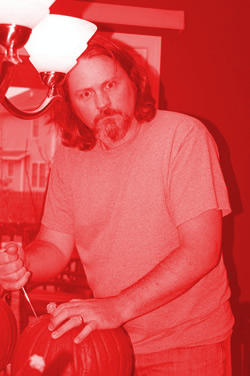 Five questions asked over a glowing Jack o'Lantern, under an Autumn moon obscured by passing clouds...in between mouthfuls of candy corn...author Dan Dillard writes mostly horror, but not always. Sometimes he writes about Halloween.
Five questions asked over a glowing Jack o'Lantern, under an Autumn moon obscured by passing clouds...in between mouthfuls of candy corn...author Dan Dillard writes mostly horror, but not always. Sometimes he writes about Halloween.
Why is Halloween important to you?
Not sure what it is about Halloween that is so magical. It could be the lore or the mystery. It's like our one time to become one with the paranormal and there's an odd feeling of safety about the day. Seems like I read that it was once a festival where families would light bonfires to warm the bones of their deceased ancestors who walked the earth on that evening. I like that idea. I'm also a huge fan of horror and the ghostly tales that seem to surround Halloween... and secretly I like the costumes and the candy. I like watching my children enjoy that aspect of it as well.
Describe your ideal Halloween.
My ideal Halloween would start with a well decorated house. That includes carved jack-o-lanterns. There would be a party with friends and family (in costumes of course). It needs to be a cool night, not too cold, and there has to be hundreds of kids bebopping from house to house with bags of treasure. Each of them ringing doorbells in hopes of scaring someone on the inside. After the kids come home with their loot, the wife and I get to watch a movie and steal all the Reese's cups.
What Halloween collectibles do you cherish, or hate, or both?
Wow, collectibles? I'm not sure. I love the figurines from the movies...Nightmare Before Christmas is a favorite. I'd love to have Jack and Sally maquettes... maybe Oogie Boogie as well.
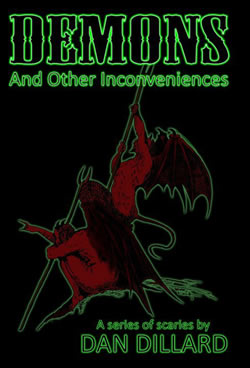 When was your very first Halloween, the one where "you really knew" it was Halloween, and how was it?
When was your very first Halloween, the one where "you really knew" it was Halloween, and how was it?
My family always celebrated Halloween. I remember when I was really young seeing my brother dressed as the Hunchback... he had latex scars on his face and fake teeth and the whole nine... That was pretty cool. I might have been 4 or 5. Think I was superman that year.
At 7 or 8 years old, I wanted to be a Tusken Raider from Star Wars...I think my mother helped sew the costume out of a tan bathrobe and my dad made the gaffi stick out of wood and styrofoam...it was pretty awesome. Pop on a little vacuformed mask and I looked great in the mirror... I also remember being Batman, Freddy Kruger, a Ghostbuster, a werewolf, and this year I'm...wait, that's top secret.
What's the one Halloween question you want to be asked, and what's your answer?
Q: Where can I get your book?
A: That's a shameless plug. I hope to hear a bunch of hopeful "Trick or Treat" s... That will be enough.
But you can still buy his book, Demons and Other Inconveniences, and What Tangled Webs, too.
Posted at 08:00 AM in Halloween (Memories) | Permalink | Comments (0)
Subscribe to Weekly Email for New Posts!
Go To...
Read My Book on Kindle
I Like to Talk
Categories
- Art/Animation (32)
- Authors (28)
- Azteca/Mexican Lobby Cards (779)
- Bloggers (48)
- Books (Bad) (2)
- Books (Fiction) (51)
- Books (Graphic) (33)
- Books (Non-fiction) (31)
- Comics/Manga (85)
- Convention/Event Programs (8)
- Death (13)
- Documentaries (11)
- Freaks/Geeks (5)
- Gift Ideas (12)
- Halloween (Memories) (54)
- Halloween Candy (36)
- Halloween Costume (70)
- Halloween Light-Ups (16)
- Halloween Novelty (91)
- Halloween Paper (63)
- Haunt Attractions (8)
- Horror Hosts (29)
- Kinema Archives (51)
- LOTT D (66)
- Magazine Morgue (261)
- Model Kits/Figures (10)
- Monster Laffs (10)
- Movies (Bad) (49)
- Movies (Drive-in) (31)
- Movies (Ghostly) (19)
- Movies (Gore) (9)
- Movies (Horror) (90)
- Movies (Indie) (33)
- Movies (Non-horror) (9)
- Movies (Slasher) (12)
- Music/Radio (13)
- Pictures (102)
- Pressbooks (Horror, Sci Fi, Fantasy) (666)
- Pressbooks (Non-Horror) (198)
- Reflections (58)
- Short Stories (2)
- Superheroes (9)
- Toys/Games (23)
- Trading Cards (16)
- TV/PC (28)
- Universal Monsters (21)
- Vintage Days (26)
- Wild West Weird (6)
- Zoc's Desk (9)
Significant Others
Other Others
Copyright Notice

From Zombos' Closet by John Michael Cozzoli is licensed under a Creative Commons Attribution-NonCommercial-NoDerivatives 4.0 International License.
Based on a work at http://www.zomboscloset.com.- Copyright© 2006-2023
From Zombos' Closet's fictional characters and personal blog posts are created and copyrighted by JM Cozzoli. Additional content is copyrighted by the respective contributors and owners of that content. From Zombos' Closet is a non-commercial site for the enjoyment of fans of the fantastique, the horrifying, the trashy, and the sublime.
